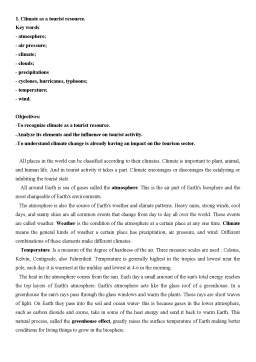Extras din proiect
1. Climate as a tourist resource.
Key words:
- atmosphere;
- air pressure;
- climate;
- clouds;
- precipitations
- cyclones, hurricanes, typhoons;
- temperature;
- wind.
Objectives:
-To recognize climate as a tourist resource.
-Analyze its elements and the influence on tourist activity.
-To understand climate change is already having an impact on the tourism sector.
All places in the world can be classified according to their climates. Climate is important to plant, animal, and human life. And in tourist activity it takes a part. Climate encourages or discourages the catalyzing or inhibiting the tourist state
All around Earth is sea of gases called the atmosphere. This is the air part of Earth's biosphere and the most changeable of Earth's environments.
The atmosphere is also the source of Earth's weather and climate patterns. Heavy rains, strong winds, cool days, and sunny skies are all common events that change from dау tо dау all over the world. These events are called weather. Weather is the condition of the atmosphere at а certain place at any one time. Climate means the general kinds of weather а certain place has precipitation, air pressure, and wind. Different combinations of these elements make different climates.
Temperature. Is a measure of the degree of hardness of the air. Three measure scales are used : Celsius, Kelvin, Centigrade, also Fahrenheit. Temperature is generally highest in the tropics and lowest near the pole, each day it is warmest at the midday and lowest at 4-6 in the morning.
The heat in the atmosphere comes from the sun. Each day а small amount of the sun's total energy reaches the top layers оf Earth's atmosphere. Earth's atmosphere acts like the glass roof of а greenhouse. In а greenhouse the sun's rays pass through the glass windows and warm the plants. These rays are short waves of light. On Earth they pass into the soil and ocean water- this is because gases in the lower atmosphere, such as carbon dioxide and ozone, take in some of the heat energy and send it back to warm Earth. This natural process, called the greenhouse effect, greatly raises the surface temperature оf Earth making better conditions fог living things to grow in the biosphere.
Precipitation. Moisture that reaches Earth's surface can be rаin, snow, sleet, or hail. Moisture can also appear in the air as water vapor (it exists as an independent gas in variable amounts). The amount оf moisture in the air depends on the temperature of the air. Warm air can hold more water than cold air. The temperature of the air also tells what kind of precipitation will fall. Rain, for ехаmple, generally falls during warm weather, while snow falls during cold weather. Raindrops has diameter of 0,5mm, where drizzle drops are smaller. Ice pellets are raindrops that have frozen in midair. Freeze rain - is rain that freezes and doesn’t touch any surface. It often produces a layer of ice that can be very slippery. Hail stone are balls of ice about 6-150 mm, they consists of raindrops that have collided and frozen together. Precipitation amounts are usually given in terms of depth.
So, humidity is the state of the atmosphere with respect to its content of water vapor, warm air being able to hold more water vapor than cold air. When the air is holding its maximum amount of water vapor it is said to be saturated.
Storms are made when huge amounts of energy stored in the water vapor in the atmosphere let go. Fierce storms — called hurricanes — sometimes form in low-latitude areas оf the Atlantic Ocean and Caribbean Sea. Low latitudes are from the Equator to 30' north and 30’ south latitude. If these storms form in the Pacific Ocean and the China Sea, they are called typhoons. In other parts of the world, they are called cyclones. Such storms have very heavy rains and high winds.
Clouds are visible masses of tiny particles of water and ice held in suspension by vertical motion of air, formed by condensation around nuclei, such as dust and smoke particles , pollen or salt. Clouds are classified according to their shape: cumulus, cirrus, stratus, and others. Fog is an opaque cloud in the ground surface layers of the atmosphere, consisting of condensed water vapor with smoke and dust particles held in suspension, that obscures vision for any distance up to one km. Sometimes fogbow appear, a virtually colorless arc of brighter light similar in form to a rainbow, see in a fog when the sun is behind the observer. And rainbow is an optical phenomenon in the form of luminous arc across the sky comprising the spectral colors. It caused by refraction and internal reflection of sunlight through falling raindrops (or water spray), when the observer stands with his back to the sun.
Temperature and precipitation together help determine what plant and animal life grows in an area. In many areas with the same climate, similar biomes are found.
Air pressure. Air has weight. This weight pushing on Earth's surface makes air pressure.
The uneven heating of Earth's surface by the sun leads indirectly to differences in air pressure. On Earth there are seven pressure zones, or areas with the same general air pressure. Two zones — those at each pole — are permanent. The other five, called belts, are semi- permanent because the belts may move more north or south when seasons change.
Sea level pressure. There are only a few percent large regions in the atmosphere that have higher pressure than the surroundings, called high –pressure areas. Regions with lower pressure than the surroundings are called low-pressure areas. Most storms occur in low-pressure areas. Rapidly fallen pressure usually means a storm is approaching, rapidly risen pressure usually indicates that sky will be clear.
Preview document
Conținut arhivă zip
- Natural Tourist Resources.doc



































